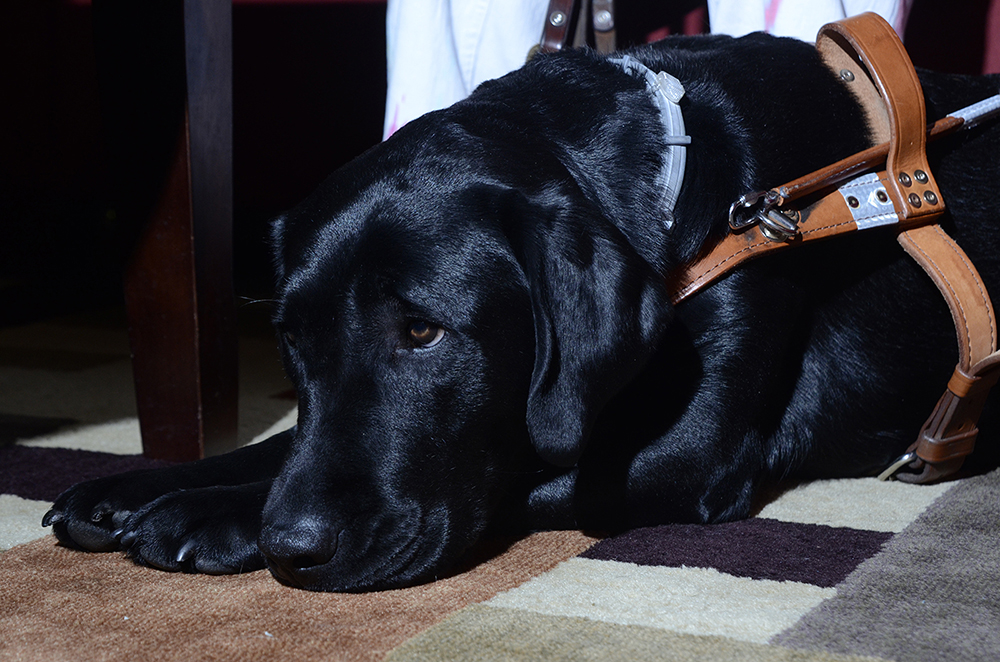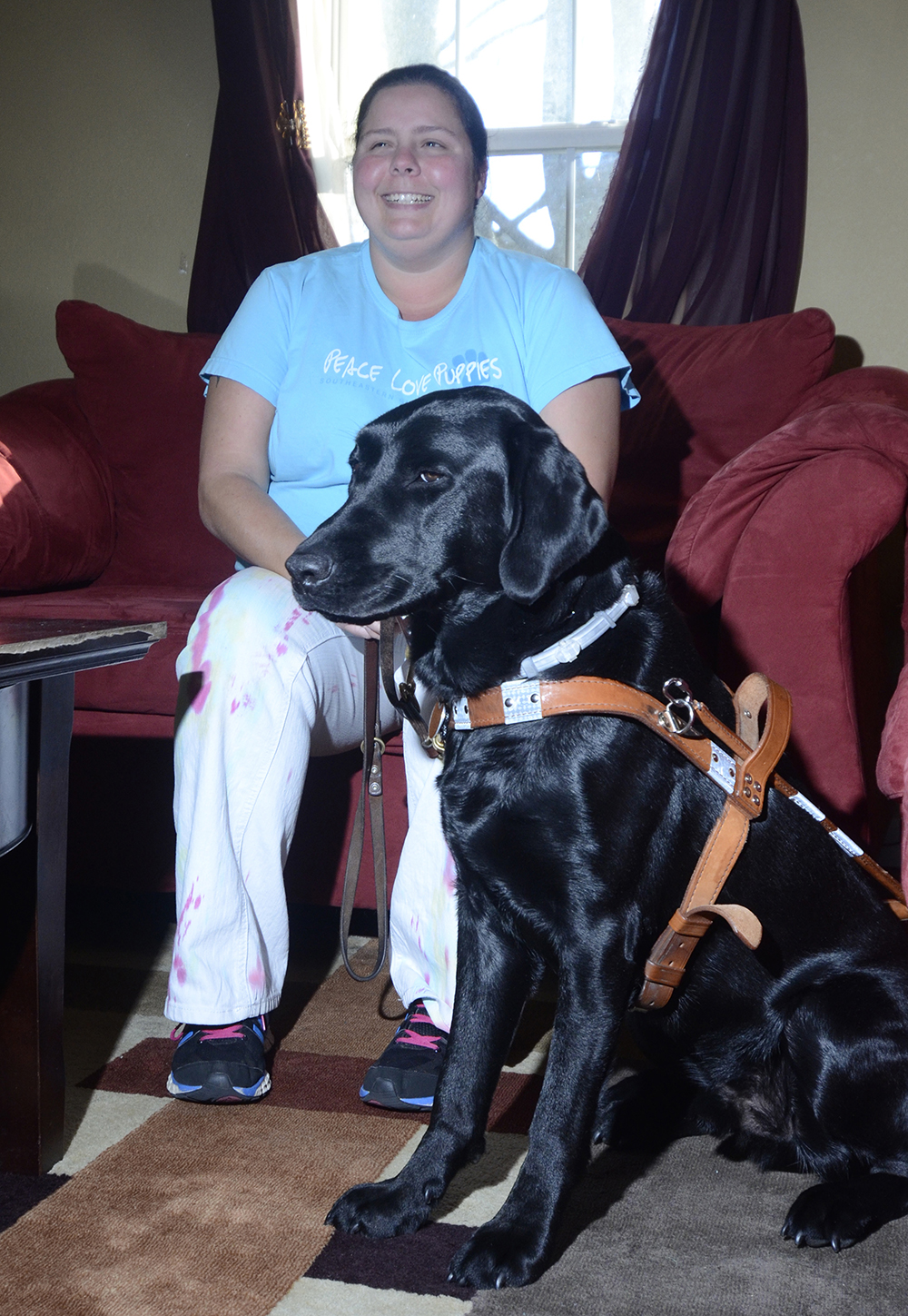Guide Dog Q&ARamona Nichols is program director at Goodwill Assistance Dog Academy in Chattanooga, which trains service dogs.Q. Is there a difference in guide dogs and service dogs?Service dogs are defined by the American Disabilities Act as any dog trained to do work or perform tasks for people with disabilities. A guide dog is one example of a service dog and is specifically a service dog trained for a person with visual impairments.Q. How long does it take to train a dog?At Goodwill Assistance Dog Academy (GADA), we start with an eight-week-old puppy, who receives a minimum of two years of initial training. Upon the completion of service dog certification tests, the canine is matched with a person on the GADA waiting list. The person must then complete 90 days of bonding consisting of trainer-supervised visits in the person's home, school and workplace, and this is followed by Team Training Camp, a two-week instructional phase where the person learns to care for and work with their dog. GADA also provides lifelong instructional support for the service dog team.Q. Is there an umbrella organization that oversees guidelines for training guide/service dogs?Yes, the Assistance Dogs International, which is a coalition of nonprofits who have the goal of improving assistance animal standards. The ADI offers an intense accreditation process which involves regular site inspections.Q. Is there a shortage of service/guide dogs?Only about 1 percent of people who seek a service dog actually receive one.Q. Is there a shortage of people to train them?Yes, the demand of service dogs far outweighs the supply.Q. What is the "working" life span of guide/service dogs?On average, 8 to 10 years.Q. Typically, what happens to the work dog when he/she retires?GADA allows the person to keep the dog if they are able. Sometimes, this isn't possible due to (the person's) disability, so (the dog) typically retires with a close family member or friend.Q. Do you prefer particular breeds?GADA uses Golden retrievers because of their size, which is conducive to working with people in wheelchairs and performing mobility service such as turning on and off lights and opening and closing doors. Other essential skills are carrying items and retrieving and being Retrievers, they are highly trainable for those skills.
Mary Downey understands that people want to pet JJ, her sweet, 2-year-old black Labrador retriever that accompanies her wherever she goes.
But what she wants you to understand is that not only does she not want you to pet or speak to JJ, she doesn't want you to even acknowledge the dog.
For good reason -- and it's not just because she's mean.
Downey, 27, is blind and JJ is a trained guide dog. When the pair are out, JJ, harnessed and tethered to Downey, is working, using all his senses to keep her safe. He alerts her when it's OK to cross a street, when to stop walking, when to go left or right, when to step down or up, and when obstacles are in the path. Someone stopping to pet JJ might send the dog into a state of confusion, causing him to falter in his duties.
When she and JJ go for a walk in her neighborhood, it's not uncommon for people to blow their horns at her. Recently, in a local Wal-Mart, an animal-loving female shopper not only petted JJ without asking permission, but talked to him in a high-pitched voice.
"Aren't you the cutest puppy? You're just beautiful and so sweet," the lady repeated over and over.
"It was obvious she loves animals, but the high pitch and affection she showed confused JJ, and he started wiggling his head and wagging his tail," Downey recalls. "He started reacting to her, and that could be aw bad thing for me. JJ was working and the diversion could have caused him to lead me in the wrong direction.
"I didn't want to be rude, but she left me no choice. I used the handle and pulled him away. He was confused because he thought it was playtime."
She says people are simply not educated as how to behave around working dogs and their people. Dogs like JJ help not only those who are visually impaired, but also those with hearing difficulties, physical disabilities, mental illness, epilepsy and autism, among other issues.
Ramona Nichols, program director of the Assistance Dog Academy at Chattanooga Goodwill Industries, is much more blunt when it comes to how to approach service dogs that they see out in public. Don't. Period. People must totally ignore them, she says.
"Do not distract the dog in any way," she says. "This includes no petting, no talking to, no calling the dog's name or making other distracting noises, no eye contact and no attempt to get the dog's attention in any way. ... Pretend the service dog is not there and simply interact with the person as you would any other person you meet."
Talking or petting the dog could lead to tragedy, she says.
"You are interrupting the guide dog, who is acting as his/her person's eyes, and you may cause serious injury to the dog and/or the person. This is very serious," Nichols continues. "Imagine a person crossing the street. A guide dog distracted at the wrong moment may not be able to warn the person of oncoming traffic, resulting in injury and even death."
Even in less-deadly circumstances, service dogs help their owners avoid obstacles, she says, so distracting them may lead to the person tripping or falling down.
And even if the person is sitting down with the dog also sitting, you shouldn't approach the animal, she says.
"Many people think that if they see a service dog quietly resting beside the person that he/she is not working. The guide dog is still working and is still on-duty. If the service dog is out with their person, the service dog is working."
The difference between JJ when he's on duty and off is staggering.
When JJ is in his harness, he is right beside Downey. If she sits, he sits. If she stands, he stands. If she walks, he walks, even if it's inside their home. But when the harness is removed, the hard-working dog morphs into a giddy, loving, playful doggy. He rolls on the floor, lifting all four legs into the air while his wagging tells slams the floor repeatedly. He walks over to others in the room for a pat on the head.
He'll grab one of his many toys and take it to Downey, where she sits laughing at JJ's playfulness.
"As soon as we get in the house and I take off his harness, he starts rolling around on the floor and wags his tail like any dog would do," Downey says. "He has toys, too. But when his harness is on, he's all business. I don't want people interfering with that."
Downey, who was diagnosed at age 13 with cone dystrophy and secondary nystagmus, rare eye diseases that have caused her to gradually lose her eyesight, was paired with JJ last June. She got the dog for free through Southeastern Guide Dogs, which is located in several cities in Florida.
"It was hard for me to get around before I got JJ," she says. "The organization went to a lot of effort to find a dog that would work well with me."
Attempts to reach Southeastern Guide Dogs were unsuccessful, but according to guidedogs.org, the organization's website, people applying for dogs train for 26 days on the campus in Palmetto, Fla., before officially receiving their guide dog. They participate in the "Freedom Walk" program, which takes them and their dogs to city streets, shopping malls and on public transportation.
"JJ and I had to learn to walk with one another," Downey says, noting that she was first paired with a female dog, but because they couldn't coordinate their gaits, JJ was brought in.
"What I liked the most about Southeastern Guide Dogs is all the effort they take to find the dogs who works best with you," she says.
According to the Southeastern Guide Dogs website, the organization not only trains dogs to assist visually impaired individuals, but also to assist veterans suffering from post traumatic stress disorder, as well as therapy dogs that are placed in military hospitals.
At Goodwill's Assistance Dog Academy in Chattanooga, it costs about $25,000 to train, care for and house each service dog, Nichols says, yet despite the costs, the academy gives its dogs away free, too. The academy is funded through proceeds from the Chattanooga Goodwill thrift stores, special event fundraisers, corporate sponsors and individual donations, she says.
The academy, a nonprofit organization, places the animals in a 23-county service area that covers Southeast Tennessee and North Georgia. They placed three dogs in June, Nichols says, and now have two 17-month-old dogs that they're training.
"We are raising money to start more dogs and hope to begin two more puppies in early 2015," she says. "Our current goal is to be able to place two dogs each year and have a total of six dogs-in-training -- two to graduate, two in the middle and two puppies."
For Downey, it took about six months from the time she applied for a dog to the day she flew to Florida.
"I don't have a lot of friends," says Downey, who explains that many people don't know how to interact with someone who is blind. "I feel like I lean to much on people for help, but JJ is changing that. He is helping me to be much more independent. ... I don't need someone's elbow or shoulder to hold onto anymore."
She's hoping the newfound independence offered by JJ will help her find a job.
"I went to school to become a massage therapist, but because I've had transportation issues, I can't find a job," she says. "And it's really a shame because I'm good at it. When I was in school, my clients said that my blindness may even make me a better masseuse because I'm more aware of the sense of touch."
Just having JJ is a comfort that gives her confidence; now she just has to use that confidence to teach others the "'rules' of a guide dog," she says.
"It's easier than me saying, 'Don't touch my dog.' I've even thought about putting a sign on JJ's harness that says, 'Please do not touch or talk to my dog.'
"It sounds rude but I can't risk getting hurt."
Contact Karen Nazor Hill at khill@timesfreepress.com or 423-757-6396.


